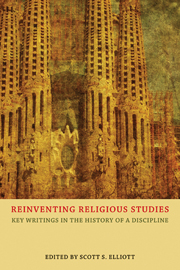Book contents
- Frontmatter
- Contents
- Introduction
- 1 For such a time as this: the Council of Societies for the Study of Religion, 1969–2009
- Part I Inventing and reinventing the field of religious studies
- 2 Why a Council on the Study of Religion?
- 3 Ironies
- 4 Religious studies: the next vocation
- 5 Impressions from Wingspread: religious studies—the state of the art
- 6 History of religions
- 7 The future of religious studies: moving beyond the mandate of the 1960s
- 8 Naming the game: a question of the field
- Part II Method and theory in religious studies
- Part III Teaching religion
- Part IV Women and the bible in religious studies
- Part V Religion and religious studies in civic life
- Part VI Religious studies and identity politics
- Part VII Islam and 9/11
- Bibliography
- Acknowledgments
- Index
4 - Religious studies: the next vocation
from Part I - Inventing and reinventing the field of religious studies
- Frontmatter
- Contents
- Introduction
- 1 For such a time as this: the Council of Societies for the Study of Religion, 1969–2009
- Part I Inventing and reinventing the field of religious studies
- 2 Why a Council on the Study of Religion?
- 3 Ironies
- 4 Religious studies: the next vocation
- 5 Impressions from Wingspread: religious studies—the state of the art
- 6 History of religions
- 7 The future of religious studies: moving beyond the mandate of the 1960s
- 8 Naming the game: a question of the field
- Part II Method and theory in religious studies
- Part III Teaching religion
- Part IV Women and the bible in religious studies
- Part V Religion and religious studies in civic life
- Part VI Religious studies and identity politics
- Part VII Islam and 9/11
- Bibliography
- Acknowledgments
- Index
Summary
Some of us have succeeded in performing a negative miracle. We have taken our subject, rich in life, and made it dull, turned the humanistic study of religions into a technology. Religious studies, having taken the path of scholarship and avoided the one of ministry, have become measured, dull, and narrowly historical. For they have lost sight of the substance and the issues of the data. They teach instead what, amidst the vivid effects and artifacts of life, we deem to be facts.
We took that road to overcome an unwanted past. I think we had no choice. When, in the early 1960s, we faced the task of ridding our field of the empty-headed preachers, pastors, and rabbis, and making a place for people who could teach and with a measure of detachment and objectivity take up the tasks of interpretation, many of us concluded that our field had to deepen its foundations in scholarship, whether scholarship of texts, or history, or philosophy, or languages. So, in the areas of history of religions, for example, we defined our courses principally in terms of periods of the religions at hand. Mine were Judaism in late antiquity, or Judaism in modern times, or American Judaism. Or we worked on literature as literature, in my case once more: classics of the Judaic tradition (entitled, to please the whimsy of a colleague, “How to read a Jewish book”).
- Type
- Chapter
- Information
- Reinventing Religious StudiesKey Writings in the History of a Discipline, pp. 38 - 42Publisher: Acumen PublishingPrint publication year: 2013



